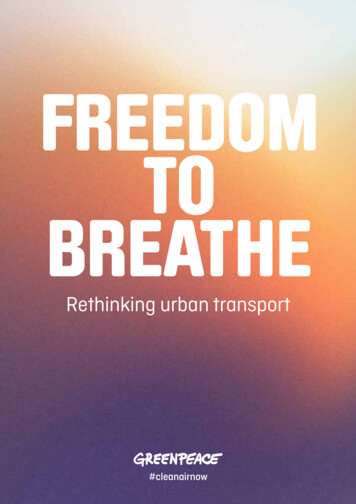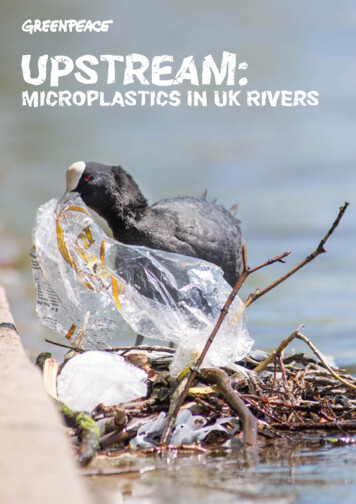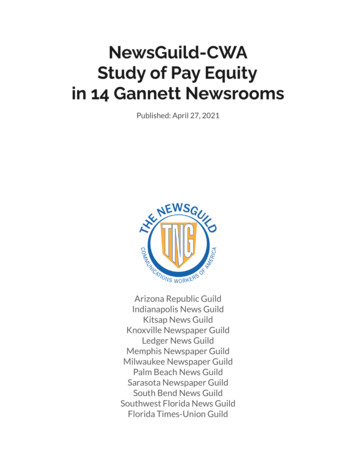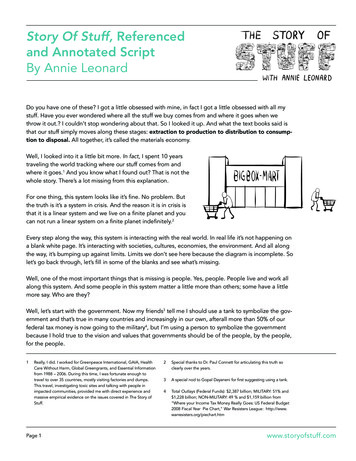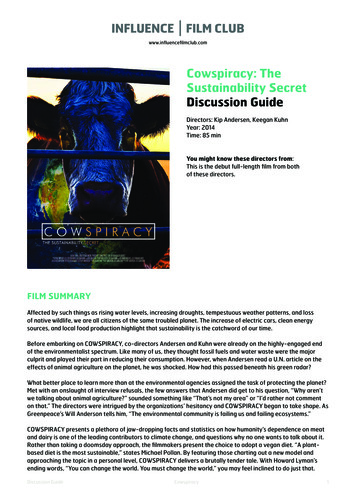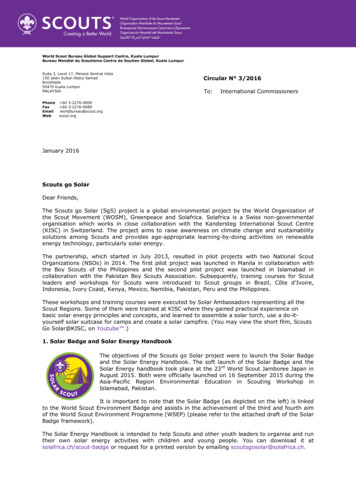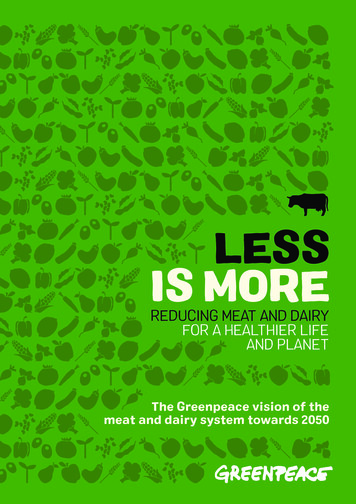
Transcription
LESSIS MOREREDUCING MEAT AND DAIRYFOR A HEALTHIER LIFEAND PLANETThe Greenpeace vision of themeat and dairy system towards 2050
ForewordThe Greenpeace vision of the meat and dairy system towards 2050LESSIS MOREREDUCING MEAT AND DAIRYFOR A HEALTHIER LIFEAND PLANETThis report is based upona more detailed technicalreview of the scientific evidencerelating to the environmentaland health implications of theproduction and consumptionof meat and dairy products:Tirado, R., Thompson, K.F., Miller,K.A. & Johnston, P. (2018)Less is more: Reducing meatand dairy for a healthier life andplanet - Scientific backgroundon the Greenpeace vision of themeat and dairy system towards2050. Greenpeace ResearchLaboratories Technical Report(Review) 03-2018Edited by:Alexandra DaweThe Greenpeace vision of themeat and dairy system towards 2050Art Direction, Design andInfographics:Christian Tatewww.christiantate.co.ukPublished in March 2018 byGreenpeace InternationalOttho Heldringstraat 5, 1066 AZAmsterdamThe vestock visionContents5Introduction: What to eat?10 The Greenpeace vision for reducingthe climate impact of meat and dairy16 Environmental impacts of meat and dairy24 Human health impacts of meat and dairy32 Concluding remarks andrecommendations40 Appendix: What Greenpeace meansby ‘ecological livestock’42 GlossaryForewordProfessor Pete SmithI have been working on the sustainabilityof agriculture and food systems for over 20years, and over this time have been involvedin hundreds of studies examining how toreduce the climate impact of agriculture, andhow to make the global food system moresustainable. What I have come to realise overthis period is that our current food system,and its future trajectory, is simply notsustainable, and we need to fundamentallychange the way we produce food if we areto feed 9-10 billion people in 2050 withoutwrecking the planet irreversibly.The component of the food system that hasthe largest single impact, is the productionof livestock to provide products for humanconsumption. In addition to the large areasof land that livestock use directly, over 30%of all of the crops we produce globally gointo livestock feed. Given that livestock areabout 10-15% efficient (at best) in convertingtheir feed into biomass that we can consume,livestock represent a huge efficiencybottle-neck in the food system. No wonderthen, that livestock products have a waterfootprint many times greater than cropproducts, and that ruminant meat has agreenhouse gas footprint 100 times that ofplant-based foods. We are not talking aboutpercentages here – we are talking about afactor of 100!Having looked at a range of potentialoptions for moving toward a sustainablefood system, including the full range ofproduction-side measures available, ithas become clear to me that we mustsignificantly reduce consumption of livestockproducts now and into the future. Producingthe same mix of foods as we consume now,even if we were to do so more sustainably,cannot deliver the reduction in environmentalimpacts we need to protect the planet forour children and their children.With an increase in human population andwith the gap between richer and poorercountries projected to get smaller, a risingmiddle class is projected to increase demandfor meat, milk and other livestock productsconsiderably. People in richer countries are2LESS IS MORE“The needto reducedemand forlivestockproductsis now ascientificallymainstreamview”Pete Smith is Professor ofSoils and Global Change atthe Institute of Biologicaland EnvironmentalSciences at the Universityof Aberdeen (Scotland,UK) and Science Directorof the Scottish ClimateChange Centre of Expertise(ClimateXChange). Since1996, he has served asConvening Lead Author,Lead Author and Authorfor the IntergovernmentalPanel on Climate Change(IPCC). His interests are inclimate change mitigationand impacts, greenhousegases fluxes, ecosystemmodelling, soils, agriculture,bioenergy, food security.He is a Fellow of the RoyalSociety of Biology, a Fellowof the Institute of SoilScientists, a Fellow of theRoyal Society of Edinburgh,a Foreign Fellow of theIndian National ScienceAcademy and a Fellow ofthe Royal Society (London).already over-consuming meat and milk, tothe detriment of global human health. Theselevels of consumption are not sustainable.We could significantly reduce meat and milkconsumption globally, which would improvehuman health, decrease environmentalimpact, help to tackle climate change, andfeed more people from much less land –perhaps freeing some land for biodiversityconservation. And we do not all need to makethe once-and-forever decision to becomevegetarian or vegan – reduced consumptionof meat and milk among people whoconsume “less and better” meat / milk couldhave a very significant impact.During the 20 or so years I have beenresearching these issues, I have come tothe unavoidable conclusion that we mustsignificantly reduce livestock productconsumption. This is not driven by avegetarian/vegan ideology, or a zeal tobecome an eco-warrior – it is driven entirelyby the scientific evidence. The need to reducedemand for livestock products is now ascientifically mainstream view.The authors of this report have assembledthe best scientific evidence from publishedreports covering agriculture, food systems,environmental and health research in anobjective and balanced fashion. They come tothe same conclusion as mainstream sciencehas come to in recent years – the current andprojected food system is unsustainable, andonly a significant decrease in meat and milkconsumption will allow us to deliver a foodsystem fit for the future – for the benefit ofhumans and the planet as a whole.Every day, and at every meal, we choosewhat we eat. We need to start makingdifferent choices, and governments need toprovide policies that help us to make theright choices, that are better for our healthand better for the planet. The system willneed to transform to meet these challenges.This report outlines a vision for how thistransformation might happen.Prof Pete Smith, FRS, FRSE, FNA, FRSBUniversity of Aberdeen, 1st February 2018GREENPEACE3
IntroductionThe Greenpeace vision of the meat and dairy system towards 2050IntroductionAn Image fromthe Greenpeacecampaign ‘Toomuch meat inschool’. Lunchmenus in a typicalFrench primaryschool will ofteninclude meaton a daily basis,together with milkproductsWhat to eat?For millions of years on a dailybasis humans have faced thesame question: What to eat?This is a question shared bothby ancestral hunter-gatherersand working parents on theirway home, wondering what tofeed their family. The availabilityof healthy food and theconsequences of the choices wemake today about our daily dietcan be very challenging to some,and overwhelming to others.However, not only does thisquestion have an impact on ourwellbeing but also on Earth itself.“The answer will determinewhat kind of future our childrenwill have, and perhaps thedestiny of our species” Elsa Palito / GreenpeaceMany of us in academia andcivil society believe that Whatto eat? is one of the mostcritical questions that will helpshape our future. The answerwill determine what kind offuture our children will have,and perhaps the destiny of ourspecies and many of the animals,microbes and plants inhabitingplanet Earth.4LESS IS MOREWhat we eat nourishes usand helps us to maintain ahealthy life, but bad choicescan also make us very sick.What food we eat, how much,and how that food is grown,is also key to the survival ofour planet.GREENPEACE5
IntroductionThe Greenpeace vision of the meat and dairy system towards 2050Meat and dairy:effect on the climateOur planet is changing and food is at the core of thosechanges. 2017 was the hottest year ever recorded,without an El Niño, and scientists are warning that the‘climate tide is rising fast’.1 The food system, includingchanges in land-use linked to agriculture,is currently responsible for a quarter of allgreenhouse gas emissions (GHGs) that causeclimate change.2 If we do nothing, by 2050 gasemissions from the food system will representmore than half of the total global emissionsassociated with human activities.3 The effectof what we eat and how we grow our food willprogressively become more impactful and morethreatening to our survival on Earth.Animal products are responsible forapproximately 60% of food-related climateemissions.4 Meat and dairy products are the elementsof our diet with the greatest damaging effects upon ourclimate, and upon the environment in general.The food system is also responsible for 80% ofthe deforestation currently taking place in some ofthe most biodiverse forests remaining on Earth, withlivestock5 and animal feed expansion being the mostprominent single driver of this destruction.6, 7, 8 Likewise,pollution arising from animal and feed farms contributesto the massive spread of dead zones in the oceans andthe degradation of many rivers, lakes, and coastal seas.So many species are going extinct at such a high ratethat some scientists are calling this moment in time theage of the ‘sixth mass extinction on Earth’.9, 10 Agriculture,and livestock in particular, can be considered as one ofthe planet’s biggest drivers of global biodiversityloss. In short, what we eat is making our planetsick. But it is also making humans sick.1. no-boost2. IPCC 2014: Smith, P., et al. 2014. Agriculture, Forestry and Other Land-Use (AFOLU).In: Climate Change 2014: Mitigation of Climate Change. Contribution of Working GroupIII to the Fifth Assessment Report of the Intergovernmental Panel on Climate Change[Edenhofer, O., et al. (eds.)]. Cambridge University Press, Cambridge, United Kingdom andNew York, NY, USA.3. Bajželj, B., et al. 2014. Importance of food-demand management for climate mitigation.Nature Climate Change, 4: 924-9294. IPCC 2014: Smith, P., et al. 2014. Agriculture, Forestry and Other Land-Use (AFOLU).In: Climate Change 2014: Mitigation of Climate Change. Contribution of Working GroupIII to the Fifth Assessment Report of the Intergovernmental Panel on Climate Change[Edenhofer, O., et al. (eds.)]. Cambridge University Press, Cambridge, United Kingdom andNew York, NY, USA.5. Livestock are domesticated animals raised in an agricultural setting to producecommodities such as meat, eggs, milk, fur, leather, and wool, and often to do work6. Hosonuma, N., et al. 2012. An assessment of deforestation and forest degradation driversin developing countriesEnvironmental Research Letters, 7: 044009.7. Kissinger, G., et al. 2012. Drivers of Deforestation and Forest Degradation. A synthesisreport for REDD Policymakers:48.8. Campbell, B. M., et al. 2017. Agriculture production as a major driver of the Earth systemexceeding planetary boundaries. Ecology and Society, 22: 8.9. Barnosky, A. D., et al. 2011. Has the Earth’s sixth mass extinction already arrived? Nature,471: 51–57.10. Joppa, L. N. et al. 2016. Filling biodiversity threat gaps. Science, 352: 416–4186LESS IS MOREMeat and dairy:effect on our healthOur diets have changed drastically in the past fewdecades. Although large regional differences remain,the general increase in the consumption of animalproducts is a global phenomenon. For example, from1989 to 2000, the global consumption of animal products‘more than tripled in rural areas and almost quadrupledin urban areas’.11 At the same time the world populationthat is undernourished went down from 19% to 11%,however in parallel the global percentage of overweightpeople increased substantially from 23% to 39%(1.9 billion currently).12Increases in the consumption of animal products, refinedgrains and sugar have all been linked to the worldwideincrease in obesity.13 The rise in the consumption ofunhealthy food means that our diets are among thetop risk factors for early death and increased riskof illness globally. A suboptimal diet (for example, lowfruit, low whole grain and low vegetable consumption,and high meat intake) is a leading risk factor for globalpremature mortality accounting for nearly one in everyfive deaths.14 Dietary risk accounted for 10 million deathsglobally in 2016, while tobacco risk was responsible for 7million deaths in the same year.15“Our diets are among the toprisk factors for early death andincreased risk of illness globally”The urgency for action to change our food systemhas never been clearer. Fortunately, experts agree westill have time to reverse these destructive trends – ifwe act quickly and in a systematic way to address allsectors of our economies and societies related to foodconsumption.In short, current production and consumption of meatand dairy products are damaging our planet by being asubstantial driver of climate change, as well as puttingour health at risk. If we reshape food systems, both inthe way we produce our food and what we decide toeat, then we can still avoid catastrophic climate changeand the destruction of nature, while, at the same time,improving human health.11. Malik, V. S., Willett, W. C. & Hu, F. B. 2012. Global obesity: trends, risk factors and policyimplications. Nature Reviews Endocrinology, 9: 1312. from 1990 and 1975 to today, respectively. As in Gordon, L. J.et al. 2017. Rewiring foodsystems to enhance human health and biosphere stewardship. Environmental ResearchLetters, 12: 100201.13. Malik, V. S., Willett, W. C. & Hu, F. B. 2012. Global obesity: trends, risk factors and policyimplications. Nature Reviews Endocrinology, 9: 13.14. Gakidou, E., et al. 2017. Global, regional, and national comparative risk assessment of84 behavioural, environmental and occupational, and metabolic risks or clusters of risks,1990-2013; 2016: a systematic analysis for the Global Burden of Disease Study 2016. TheLancet, 390: 1345-1422.15. Ibid.“Greenpeace iscalling for a globalreduction of 50%in production andconsumption ofanimal productsby 2050”The GreenpeacevisionIn this report, we try to answer the question of What to eat?by reviewing the scientific evidence pointing at the ways inwhich changes to the global food system can help to achieve ahealthy population and healthy planet. In particular, we focus onhow reducing meat and dairy consumption and production cancontribute to preserving climate, biodiversity and water systems,while improving the wellbeing of humans, now and into the future.The structure of this report reflects the various threatsgenerated by our excessive production and consumption of meatand dairy. Climate change is the clearest threat to our life on theplanet requiring urgent action. For this reason, this report startsby explaining the scientific rationale for improving our dietarychoices in terms of greenhouse gas emissions from the meat anddairy system (Chapter 1).In addition to acting to prevent climate change, we mustalso ensure the preservation of other living creatures andecosystems that make human life on Earth possible.We dedicate Chapter 2 to reviewing the impacts of meat anddairy systems on the environment.Planetary health must include the health of humans. Humanhealth is affected by what we eat and by the global changesset in motion by trends towards increasingly meat-heavy diets.Chapter 3 evaluates current scientific evidence on the impacts ofa meat-heavy diet on human health and how changing our dietsto include more plants and less meat and dairy could make usmore healthy.We conclude with recommendations and demands togovernments, corporations and individuals on how we, if we actquickly and sensibly, can still ensure a green and peaceful planeton which our children can enjoy healthy lives.This report clearly illustrates that the current livestock system isone of the sectors that will decide our future and survival on theplanet. Greenpeace believes that this strong scientific evidencemust translate into urgent global action. In order to protect thehealth of our children and of our planet for future generationsfrom the impacts of industrial meat production we urgentlyneed to start eating more plant-based food and less meat. If wechoose to eat meat sometimes, the best option is to buy it fromlocal ecological farmers.Greenpeace is calling for a global reduction of 50% inproduction and consumption of animal products by 2050as compared to the current situation16. Achieving this goalis possible under a vision of ecological farming. In otherwords, we propose a level of production that ensures foodsecurity while protecting the climate and biodiversity.16. Please note that the latest data from FAOSTAT is year 2013 (as of January 2018), so that is thereference year for the Greenpeace goal.GREENPEACE7
IntroductionOur approach toMeat and DairyAlthough not all meat types are equally harmfulin terms of their contribution to climate change,degradation of the wider environment and thenegative effects on human health, we concludethat the best approach is to tackle the meat anddairy sector in a holistic1 way, including all typesof animal products from both a production andconsumption perspective.Many animal products have significantnegative environmental and social impactsrelative to plant-rich foods. The magnitude ofthe impact of each food can differ in terms of thespecific elements associated with it, for example,climate gases related to a per kilo unit. Other impactsare indirect and transversal, such as those that involveworkers rights or animal welfare.2, 3 Hence the suggestionthat the best approach is a holistic one.Human preferences for different animal productsare undergoing significant shifts. So while chickencan be seen as less impactful than beef on a kgby kg comparison of climate emissions, the globalenvironmental footprint of chicken production andconsumption is massive. This is due to the fast risingtrend in poultry consumption and the very largeabsolute production and consumption volumes.Between 1990 and 2013, while there was a 10% decreasein global beef consumption per capita, there was a 23%increase in pork and a striking 96% increase in poultryconsumption (Figure 1). The production of pigs andchickens already represents 70% of the total meatproduction globally. China’s consumption of pigs andchicken has become globally relevant, as the countryimports 20% of the total soy production exported fromBrazil, as non-ruminant feed.4 As such it is importantto consider the negative environmental contribution ofother meat types, besides beef, to land-use changes anddeforestation linked to the production of feed, of whichpoultry and pork are big consumers.In addition, growth in total meat consumption isprojected to be driven largely by poultry and pork, notbeef or other red meats such as sheep or goat. Poultry isexpected to overtake pork as the most consumed meatin the world by 2022.5 Likewise, the consumption of milk1. Holistic: systemic approach in which the parts of something are considered to beintimately interconnected and explicable only by reference to the whole. Ecologicalproblems usually require holistic solutions.2. Oxfam America 2015. Lives on the Line - the human cost of cheap chicken.3. IATP et al. 2017. The rise of big meat. Brazil’s extractive industry.4. Galloway, J. N.et al. 2007. International Trade in Meat: The Tip of the Pork Chop. Ambio,36: 622-629.5. Henchion, M., et al. 2014. Meat consumption: Trends and quality matters. Meat Science,98: 561-568.8LESS IS MORE Jean-Luc Bertini / GreenpeaceThe Greenpeace vision of the meat and dairy system towards 2050Annual global averageconsumption of different meat types15Consumption(kg per personper year)Pigs in Wendland,Lower Saxony,Germany. The farmis a member of theNeuland (Newland)label, that hashigh standards inanimal welfareand Beef20052010The production of pigsand chickens already represents70% of the total meatproduction globally2015Mutton andgoatFigure 1. Consumption of beef, mutton and goat meat, pork and poultrymeat, the major meat types globally, from 1970 to 2013 in kg of product perperson per year (carcass weight, meaning raw unprocessed products at thepoint of retail sale).Data from FAOSTAT, 2018.and dairy products is expected to rise, with productionincreasing by more than 1.8% per year. This growth willbe most intense in countries like China, India and Brazil.6Dairy cows are also a major consumer of feed crops.Feed production has significant negative impactson forests, water resources and our climate, andcontributes to food insecurity where land is usedto feed animals instead of feeding people directly.Conversion of feed to animal food is largely inefficient.As little as 3% of the plant calories in feed are convertedinto calories in beef, for example.7Different types of meat have negative impactson various key issues. While beef production hasgreater impact on the climate, chicken is often atthe centre of foodborne infectious disease problemsbecause of associated bacteria and other pathogens.Campylobacter and Salmonella infections accountfor more than 90% of all reported cases of bacteria6. FAO 2010: Status of and Prospects for Smallholder Milk Production – A GlobalPerspective, by T. Hemme and J. Otte. Rome.7. Shepon, A., et al. 2016. Energy and protein feed-to-food conversion efficiencies in the USand potential food security gains from dietary changes. Environmental Research Letters,11:105002.related food poisonings worldwide. Most of thesecases are related to the consumption of poultryproducts.8 Globally, as mentioned, the increase in poultryconsumption is a major component in the overallincrease of all meat consumption9 and, therefore, is likelyto increase in importance in relation to the causes ofhuman disease.The number of chickens, pigs and cattle slaughteredper capita more than tripled between 1961 and 2009,reaching over ten animals slaughtered for every personon Earth in 2009. If this rate continues to hold, 76 billionanimals will be slaughtered to satisfy meat anddairy consumption this year.10 The ethical dimension ofensuring the wellbeing of all these animals is, therefore,also a very important factor that needs to be considered.In this report we have not included seafood because ourfocus has been on the land-based agriculture and foodsystems. However, fishing is a main driver of biodiversityloss in our oceans. Overfishing and habitat destructionhave significantly degraded marine ecosystemsworldwide. That said, fishing plays a major role inmeeting the basic needs of some of the most vulnerablecommunities on Earth and makes a critical contributionto global food security.8. FAO: Poultry and poultry products - risks for human health.9. Kearney, J. 2010. Food consumption trends and drivers. Philosophical Transactions ofthe Royal Society B: Biological Sciences, 365: 2793.10. Source of estimate is Allievi, F., Vinnari, M. & Luukkanen, J. 2015. Meat consumption andproduction – analysis of efficiency, sufficiency and consistency of global trends. Journalof Cleaner Production, 92: 142-151. According to FAOSTAT, number of cattle, pig, poultry,sheep and goat slaughtered for meat and dairy production totalled 73.4 billion in 2016. Ofthose, 66 billion are chicken.“If the rate continues to hold, 76billion animals will be slaughteredto satisfy meat and dairyconsumption this year”Low-impact small-scale fishing has the potential to coexist with well-preserved ecosystems and abundant fishpopulations, as well as to support the lives of hundredsof millions of people. Fishing and trade policies should bedesigned to ensure that priority access to fish resourcesis granted to small-scale low-impact fishers and tovulnerable communities that depend on seafood to meettheir basic nutritional needs. A large majority of globalfish stocks have been fully exploited or overfished yetseafood is one of the most internationally traded foodcommodities. Ensuring food security for vulnerablecommunities will involve questioning the currentappetite for fish in rich societies and diminishing fishconsumption, particularly of fish products that areassociated with environmental impacts.GREENPEACE9
Reducing the climate impact of meat and dairyThe Greenpeace vision of the meat and dairy system towards 2050chapter oneThe Greenpeace vision forreducing the climate impactof meat and dairyTo meet the goals of the Paris Climate Agreement andensure a safe climate by 2050, the world needs arevolution in food production, in addition to thedecarbonising of all other sectors and increasesin carbon sequestration.To limit the global average temperatureincrease to 1.5ºC, we need to addressmeat production due to its currentlarge greenhouse gas (GHG)emissions and potentially evenlarger contributions in thefuture.1, 2, 3According to recent scenarioson climate gases, emissionsfrom the food system goingforward to 2050 have beenestimated to reach 20.2 billiontonnes of carbon dioxideequivalent (CO2e) per year4,including land-use change, inthe baseline scenario.5, 6Visualising agricultural emissionsThe significance of emission reductions from our current food consumptiontowards a plant-rich diet can be illustrated very simply. Imagine a bus with 20seats available for GHGs to limit global warming to 1.5ºC by 2050.2050Globalaveragetemperatureincrease of1.5ºCOut of these 20 seats, 11 are projected to be taken by the food system, if wecontinue to increase meat consumption. This only leaves 9 seats for other essentialsectors in our economies (energy, industry, transport and beyond). This will be a very crowdedbus and probably lead to overflowing and a dangerous journey ahead.This means that the GHGemissions from agriculturealone takes nearly thefull 1.5ºC target emissionsallowance by 2050 for allsectors, including energy,industry, transport and others (21 3 billion tonnes of CO2e per year).7This fact alone underpins the urgentneed, and the opportunity, for tacklingfood-related emissions, particularly emissionsfrom meat and dairy production.2050Globalaveragetemperatureincrease of1.5ºCFortunately, if we collectively move to a plant-rich diet, we can free up 7seats on that bus, thus largely increasing our chances of safely arriving at ourdestination in 2050. In addition, freeing up those seats will also ensure better humanhealth due to improved diet, and a much better prospect for protecting nature.Food system emissions in this example do not include land-use change.Currently, direct GHG emissions from the agriculturesector account for 24% of all global emissions, andlivestock emissions (including land-use change) accountfor 14%, which is comparable to the emissions from thewhole transport sector.81. Rogelj, J., et al. 2016. Paris Agreement climate proposals need a boost to keep warmingwell below 2 C. Nature, 534: 631-639.2. Bajželj, B., et al. 2014. Importance of food-demand management for climate mitigation.Nature Climate Change, 4: 924-929.3. Hedenus, F., et al. 2014. The importance of reduced meat and dairy consumption formeeting stringent climate change targets. Climatic Change, 124: 79-91.4. Billion tonnes or Gigatonnes (Gt) of carbon dioxide equivalent (CO2e) is a unit thatcombines the emissions of different greenhouse gases into one unit to enable comparisonbecause the impact of different greenhouse gases on the atmosphere is not the same.Methane (CH4) is 25 times more potent than CO2; nitrous oxide is 298 times as potentas CO2. All scenarios are expressed in terms of billions of tonnes of global annual CO2equivalent emissions per year (Gt CO2e yr-1).5. The baseline scenario is the Business as Usual (BAU) scenario which assumes nomajor changes in trajectory, so that normal circumstances can be expected to continueunchanged.6. Bajželj, B., et al. 2014. Importance of food-demand management for climate mitigation.Nature Climate Change, 4: 924-929. This analysis is for limits between 1.5º and 2º C.7. Ibid.8. IPCC 2014: Smith, P., et al. 2014. Agriculture, Forestry and Other Land-Use (AFOLU).In: Climate Change 2014: Mitigation of Climate Change. Contribution of Working GroupIII to the Fifth Assessment Report of the Intergovernmental Panel on Climate Change[Edenhofer, O., et al. (eds.)]. Cambridge University Press, Cambridge, United Kingdom andNew York, NY, USA.10LESS IS MOREClimate emissions from agriculture are projectedto continue to increase in absolute as well asrelative terms reaching 52% of global emissionsin 2050, as population and economic growth bringsabout increases in food production and waste, as well asshifting diets towards those that are meat-heavy.9Technical mitigation potential within agricultureproduction appears to be less effective than in othersectors, hence the need to address emissions from thefood system as a whole, including both the productionand consumption of animal products due to theirintensity in greenhouse gas emissions.109. Bajželj, B., et al. 2014. Importance of food-demand management for climate mitigation.Nature Climate Change, 4: 924-929.10. Ibid.GREENPEACE11
Reducing the climate impact of meat and dairyMontbéliardecattle at anecological dairyfarm in France Jean-Luc Bertini / GreenpeaceThe Greenpeace vision of the meat and dairy system towards 2050The Greenpeacevision-10The Greenpeace vision for ecological farming8 is of afood system in which there is enough food for all, butone which minimises environmental damage duringits production. For livestock, that means animalsare reared respectfully and without suffering, usingland that is not required for human food production,yet maintaining enough land for biodiversity. Recentscientific models validate this vision of feeding the worldwith ecologically-grown food. Reducing food waste andmeat consumption are imperative for a future based onecological food and farming.9“Ecological livestock rely only ongrasslands, pasture and residuesfor feed to ensure food securityand a healthy planet”Currently, direct GHGemissions from the agriculturesector account for 24% of all glob
become an eco-warrior - it is driven entirely by the scientific evidence. The need to reduce demand for livestock products is now a scientifically mainstream view. The authors of this report have assembled the best scientific evidence from published reports covering agriculture, food systems, environmental and health research in an
